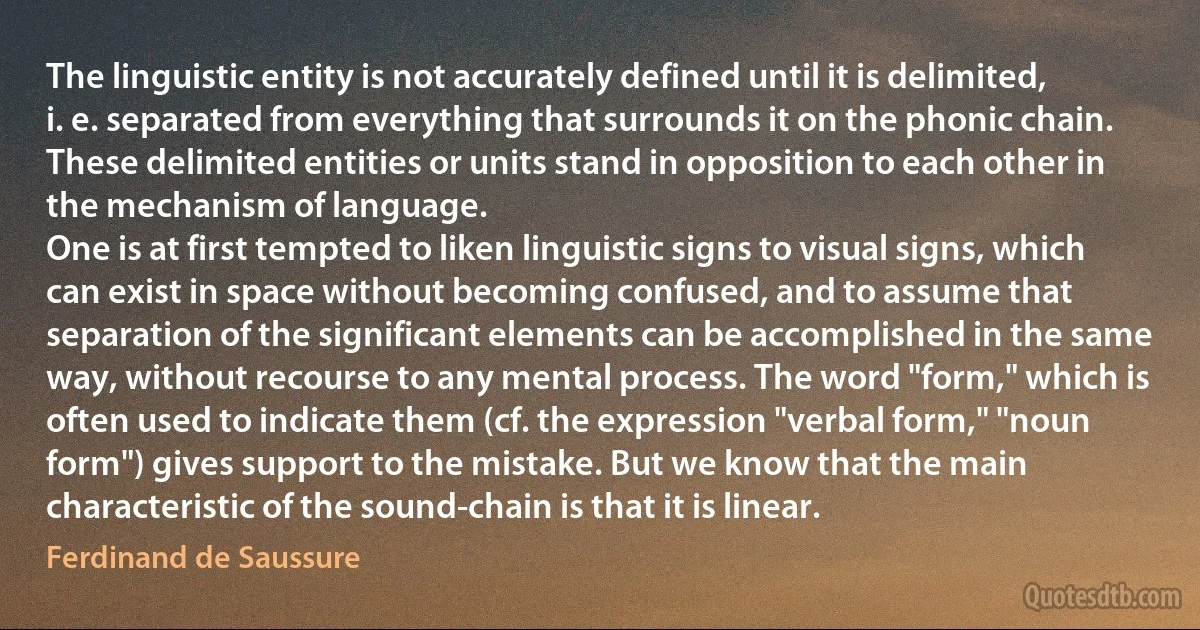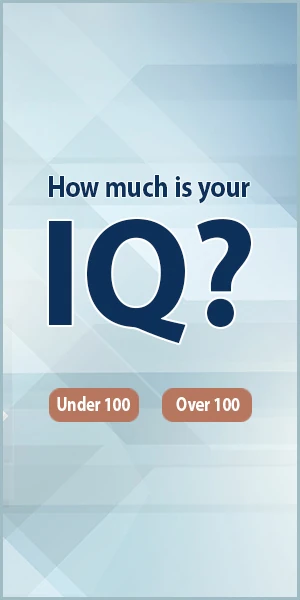
The linguistic entity is not accurately defined until it is delimited, i. e. separated from everything that surrounds it on the phonic chain. These delimited entities or units stand in opposition to each other in the mechanism of language. One is at first tempted to liken linguistic signs to visual signs, which can exist in space without becoming confused, and to assume that separation of the significant elements can be accomplished in the same way, without recourse to any mental process. The word "form," which is often used to indicate them (cf. the expression "verbal form," "noun form") gives support to the mistake. But we know that the main characteristic of the sound-chain is that it is linear.
Ferdinand de SaussureRelated topics
becoming chain characteristic entity everything form gives language linear mechanism mistake noun recourse significant space stand support visual way word surroundsRelated quotes
The assumption that the human psyche possesses layers that lie below consciousness is not likely to arouse serious opposition. But... there could just as well be layers lying above consciousness... The conscious mind can only claim a relatively central position and must put up with the fact that the unconscious psyche transcends and as it were surrounds it on all sides. Unconscious contents connect it backward with the physiological states on the one hand and archetypal data on the other. But it is extended forward by intuitions which are conditioned partly by archetypes and partly by subliminal perceptions depending on the relativity of time and space in the unconscious.

Carl Jung
[The Constructive idea.. ] has revealed a universal law that the elements of a visual art such as lines, colours, shapes, possess their own forces of expression independent of any association with the external aspects of the world; that their life and action are self-conditioned psychological phenomena rooted in human nature; that those elements are not chosen by convention by any utilitarian or other reason as words and figures are, they are not merely abstract signs, but they are immediately and organically bound up with human emotions. The revelation of this fundamental law has opened up a vast field in art giving the possibility of expression to those human impulses and emotions which have been neglected.

Naum Gabo
Evolutionary psychology was the organizing framework-the source of "explanatory adequacy” or a "theory of the computation”-that the science of psychology had been missing. Like vision and language, our emotions and cognitive faculties are complex, useful, and nonrandomly organized, which means that they must be a product of the only physical process capable of generating complex, useful, nonrandom organization, namely, natural selection. An appeal to evolution was already implicit in the metatheoretical directives of Marr and Chomsky, with their appeal to the function of a mental faculty, and evolutionary psychology simply shows how to apply that logic to the rest of the mind.

Steven Pinker
[T]here was one principle underlying their approach to all these problems-a principle upon which they stood in fundamental opposition to Socialism. The Conservative objective was a nation-wide property-owning democracy. Both parties believed in a form of capitalism, but whereas their opponents believed in State capitalism they believed in the widest measure of individual capitalism. Man should be master of his environment, and not its slave. That was what freedom meant. ... [W]e of the Conservative Party must maintain that the ownership of property is not a crime or a sin, but a reward, a right, and a responsibility that must be shared as equitably as possible among all our citizens.

Anthony Eden
It is one of the most beautiful characteristics of Theosophy that it gives back to people in a more rational form everything which was really useful and helpful to them in the religions which they have outgrown... in this teaching as to the immortality of the soul and the life after death, Theosophy...does not put forward these great truths merely on the authority of some sacred book of long ago; in speaking of these subjects it is not dealing with pious opinions, or metaphysical speculations, but with solid, definite facts, as real and as close to us as the air we breathe or the houses we live in - facts of which many among us have constant experience - facts among which lies the daily work of some of our students, as will presently be seen.

Charles Webster Leadbeater
